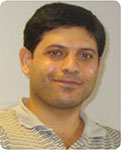Permeability prediction from mercury injection capillary pressure: an example from the Perth Basin, Western Australia
Adnan Al Hinai A , Reza Rezaee B A , Ali Saeedi A and Roland Lenormand CA Curtin University
B Department of Petroleum Engineering
C Cydarex
The APPEA Journal 53(1) 31-36 https://doi.org/10.1071/AJ12003
Published: 2013
Abstract
For shale gas reservoirs, permeability is one of the most important and difficult parameters to determine. Typical shale matrix permeabilities are in the range of 10 microdarcy–100 nanodarcy, and are heavily dependent on the presence of natural fractures for gas transmissibility. Permeability is a parameter used to measure the ability of a rock to convey fluid. It is directly related to porosity and depends on the pore geometry features, such as tortuosity, pore shape and pore connectivity. Consequently, rocks with similar porosity can exhibit different permeability.
Generally, permeability is measured in laboratories using core plugs. In some cases, however, it is difficult to obtain suitable core plugs. In these instances, other approaches can be used to predict permeability, which are chiefly based on mathematical and theoretical models. The approach followed in this peer-reviewed paper is to correlate permeability with capillary pressure data from mercury injection measurements. The theoretical and empirical equations, introduced in the literature for various conventional and unconventional reservoir rocks, have been used to predict permeability. Estimated gas shale permeabilities are then compared with results from transient and steady state methods on small pieces of rocks embedded in a resin disk. The study also attempts to establish a suitable equation that is applicable to gas shale formations and to investigating the relationship between permeability and porosity.

Adnan Al Hinai is a PhD student in the Department of Petroleum Engineering at Curtin University. His research focuses on pore network modelling of gas shale reservoirs to investigate fluid flow mechanisms. His study examines various techniques to obtain shale gas flow properties, Focused ion beam/scanning electron microscop (FIB/SEM) images to reconstruct a three-dimensional model of the original pore, nuclear magnetic resonance to assess the pore size distribution and mercury injection tests to determine the pore throat sizes. Adnan was awarded his Masters degree in Petroleum Engineering in 2010 after completion of his BSc in Mechanical Engineering in 2008, both from Curtin University. Adnan.al-hinai@postgrad.curtin.edu.au |

Reza Rezaee of Curtin University's Department of Petroleum Engineering has a PhD (reservoir characterisation). He has more than 25 years of experience in academia. He has supervised more than 60 MSc and PhD students during his university career to date. He has published more than 120 peer-reviewed journal and conference papers and is the author of three books about petroleum geology, logging, and log interpretation. His research has been focused on integrated solutions for reservoir characterisation, formation evaluation, and petrophysics. Presently, he is focused on unconventional gas, including gas shale and tight gas sand studies. He is lead scientist for the WA: ERA (EIS) tight gas and shale gas research projects. He established Curtin University's unconventional gas research group in 2010. R.Rezaee@exchange.curtin.edu.au |

Ali Saeedi works with Curtin Petroleum Engineering as a lecturer in petroleum reservoir engineering and carbon capture and storage (CCS). Ali’s research interests include multi-phase flow in porous media, enhanced hydrocarbon recovery, special core analysis, carbon capture and storage and seal integrity analysis. He holds a BSc in Mining Engineering and an MSc and a PhD in Petroleum Engineering. Ali.Saeedi@curtin.edu.au |

Roland Lenormand has a PhD in Theoretical Physics from University of Paris. He worked in academic research at the National Center for Scientific Research (CNRS) in Toulouse (France) for 10 years. His research was on the theory of multiphase flow in porous media, focusing on the use of network modelling and percolation theory. Afterwards he joined Schlumberger in Ridgefield and Dowell Schlumberger in France where he worked on carbonate acidizing. He has been involved in various experimental and simulation aspects of petrophysics and special core analysis. He is now in charge of a small company (Cydarex) that commercialises laboratory software and permeability measurement techniques. roland.lenormand@cydarex.fr |


